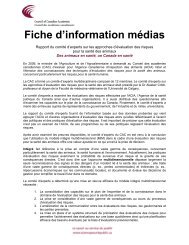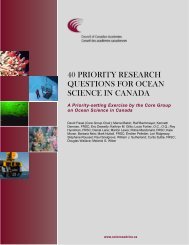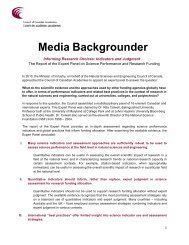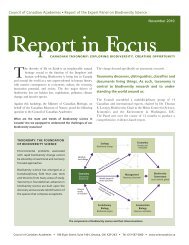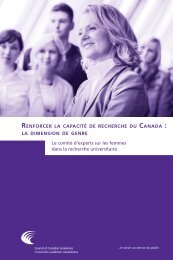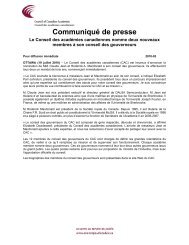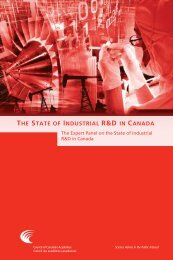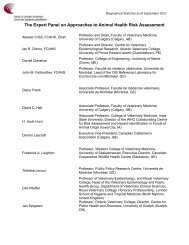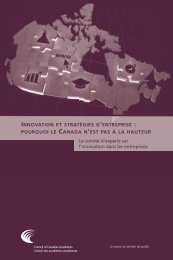an assessment of the evidence - Council of Canadian Academies
an assessment of the evidence - Council of Canadian Academies
an assessment of the evidence - Council of Canadian Academies
- No tags were found...
Create successful ePaper yourself
Turn your PDF publications into a flip-book with our unique Google optimized e-Paper software.
8 Influenza Tr<strong>an</strong>smission <strong>an</strong>d <strong>the</strong> Role <strong>of</strong> PPRE: An Assessment <strong>of</strong> <strong>the</strong> EvidenceSeasonal <strong>an</strong>d P<strong>an</strong>demic Influenza: The protective capacities <strong>of</strong> PPRE <strong>an</strong>d o<strong>the</strong>rinterventions apply to both seasonal <strong>an</strong>d p<strong>an</strong>demic influenza. During a p<strong>an</strong>demic<strong>the</strong> absolute benefit <strong>of</strong> <strong>the</strong>se interventions in preventing disease tr<strong>an</strong>smission maybe greater th<strong>an</strong> for seasonal outbreaks for reasons related to <strong>the</strong> previously-noteddifferences between seasonal <strong>an</strong>d p<strong>an</strong>demic influenza – e.g., in a p<strong>an</strong>demic <strong>the</strong>rewill be no prior immunity; <strong>the</strong> disease may be more severe; <strong>an</strong>d a vaccine is unlikelyto be immediately available.Conclusions on Protective Measures Against Influenza Tr<strong>an</strong>smission1. The primary elements <strong>of</strong> protection against influenza tr<strong>an</strong>smission areengineering <strong>an</strong>d administrative controls. When exposure to <strong>an</strong> infectedperson is required or unavoidable, PPRE is <strong>the</strong> final layer <strong>of</strong> protection.2. N95 respirators protect against <strong>the</strong> inhalation <strong>of</strong> nasopharyngeal, tracheobronchial<strong>an</strong>d alveolar-sized particles.3. Surgical masks worn by <strong>an</strong> infected person may play a role in <strong>the</strong>prevention <strong>of</strong> influenza tr<strong>an</strong>smission by reducing <strong>the</strong> amount <strong>of</strong> infectiousmaterial that is expelled into <strong>the</strong> environment.4. Both surgical masks <strong>an</strong>d N95 respirators <strong>of</strong>fer a physical barrier to contactwith contaminated h<strong>an</strong>ds <strong>an</strong>d ballistic trajectory particles.5. The efficiency <strong>of</strong> <strong>the</strong> filters <strong>of</strong> surgical masks to block penetration <strong>of</strong>alveolar <strong>an</strong>d tracheobronchial-sized particles is highly variable. Whencombined with <strong>the</strong> inability to ensure a sealed fit, <strong>the</strong>se factors suggest thatsurgical masks <strong>of</strong>fer no signific<strong>an</strong>t protection against <strong>the</strong> inhalation <strong>of</strong>alveolar <strong>an</strong>d tracheobronchial-sized particles.6. The efficiency <strong>of</strong> <strong>the</strong> filters <strong>of</strong> surgical masks to block penetration <strong>of</strong>nasopharyngeal-sized particles is unknown. The lack <strong>of</strong> a sealed fit on asurgical mask will allow for <strong>the</strong> inhalation <strong>of</strong> <strong>an</strong> unknown qu<strong>an</strong>tity <strong>of</strong>nasopharyngeal-sized particles.





